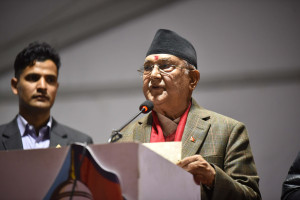Editorial
Of suitcases and caskets
The sorry saga of Dhan Bahadurs who go abroad with big dreams returning home dead should end.
“So many people, how did they all die?” asks an old war veteran in an intensely chilling scene in Fidel Devkota's film The Red Suitcase, set to release Friday, April 12. The ex-lahure, played by Bipin Karki, is shocked to know from his interlocutor, a mortuary vehicle driver, about the number of dead bodies of Nepali migrant workers that arrive at the airport each day. The driver, played by Saugat Malla, then says, “The government is responsible for all these deaths.” In the film, Malla's character is seen riding his jeep to Malewa village to deliver the corpse of Dhane, who is yet another victim of sub-human working conditions in Qatar, where he went as a migrant worker to build a football stadium for the 2022 World Cup. The casket that carries Dhane’s dead body is accompanied by a red suitcase inside which is a cacophony of dreams, despair and death.
Devkota’s directorial feature film debut triumphs in its visual representation of the trials and tribulations of Nepalis who have lost their lives building somebody else’s country. It crudely reminds viewers of the failure of the Nepali state, even as it depends on remittance to provide for its citizens. The cost of remittance is unimaginably high. Numbers hardly show the intensity of the costs to human lives, but as Qatar built seven stadiums to host the World Cup, over 6,500 migrant workers from Nepal, India, Pakistan, Sri Lanka and Bangladesh died between 2010 and 2021. Many more have perished in other workplaces in the Gulf, South Korea and Malaysia in Southeast Asia. According to the New York Times, at least 2,100 Nepali workers died in Qatar while 3,500 died in Malaysia, around 3,000 in Saudi Arabia, and at least 1,000 in the United Arab Emirates.
No wonder that each day, caskets and suitcases of deceased Nepalis arrive at the Tribhuvan International Airport. According to the Department of Foreign Employment, 680 Nepali migrant workers died in the fiscal year 2019-20 while the figure stood at 1,275 in 2020-21. Similarly, 1,509 workers died in the fiscal year 2021-22 while 1,208 did in the fiscal year 2022-23. The Nepal Rastra Bank’s data for the first six months of the fiscal year 2023-24 shows remittance increasing by 25.3 percent, to Rs733.22 billion. Having found little or no way to bring down inflation and increase exports, the government is intent on sending its youths to the labour markets hoping to bring in more remittance. And with growing remittance comes the risk of more migrant deaths.
The story of Nepali youths toiling in the dangerous labour markets of the Gulf and Southeast Asian countries is now over three decades old, and it seems to have no end in sight. What’s more, successive governments have failed to own up their complicity in the trials, tribulations and deaths of the Nepalis abroad. The story saga of Dhan Bahadurs and their dreams of a good life returning home in caskets and suitcases must end.




 12.12°C Kathmandu
12.12°C Kathmandu












%20(1).jpg&w=300&height=200)

